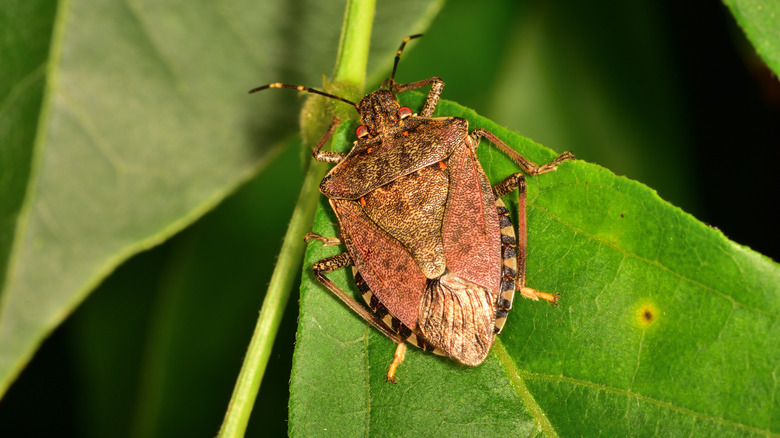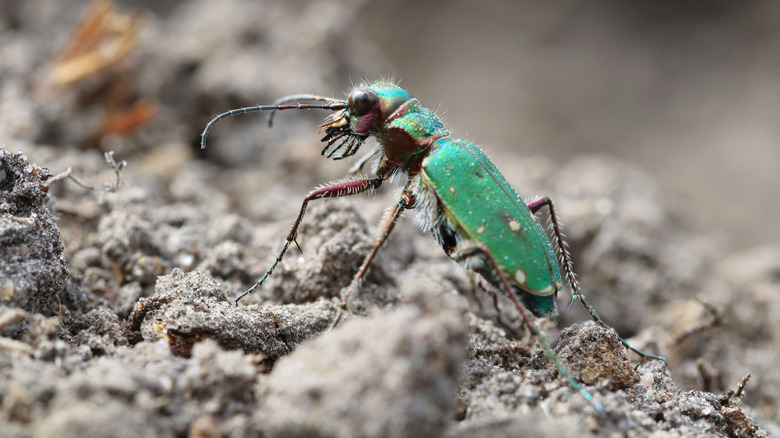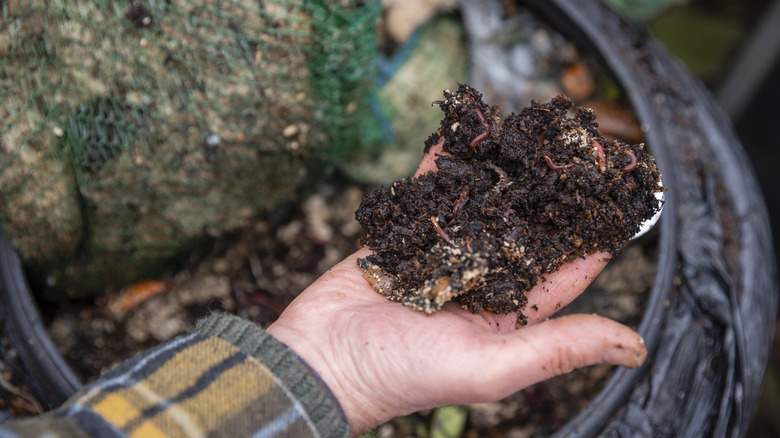Simple Ways Gardeners Can Help Prevent A Further Decline In Insect Populations
When it comes to our gardens, certain insects are generally considered a nuisance at best, and a plague at worst. No one wants a greedy slug or a lazy snail decimating their prize plants or a curious caterpillar munching upon their leaves. However, bugs in all shapes and sizes are essential to the planet's ecosystems. And at a time when 40% of insect species are threatened by extinction, we should be doing all we can to avoid the coming bug apocalypse — even if that means making our gardens as insect-friendly as possible. A global scientific review published in 2019 reported that insect numbers are being reduced annually by 2.5%.
The University of Sussex biology professor Dave Goulson warned CNN that the continuing decline in insect populations would have severe consequences for everyone. "Three-quarters of our crops depend on insect pollinators. Crops will begin to fail. We won't have things like strawberries. We can't feed 7.5 billion people without insects." he said. Although pesticides and climate change are key factors in what the report brands a "catastrophic decline in the abundance and diversity of insects," the biggest problem is loss of habitat. Something anyone with a garden can help combat as Goulson points out, "Insects live in our parks and gardens. Gardeners can make a real difference." If you're ready to do battle on behalf of anything that crawls, slithers, or flies, here are some simple ways you can take direct action.
Let your garden run a little wild
A gang of unruly weeds, a host of obnoxious brambles, and a loose affiliation of flowers growing chaotically is enough to keep diligent soul who prides themselves on a well-maintained and orderly garden up at night. Yet there's more to life than clearly defined borders and manicured lawns. There are insects who are essential to all life on Planet Earth and who adore a little wilderness to feel at home in. So stop worrying about fallen leaves, the integrity of your patio, and the cut of your grass, and let it blossom, let it grow, and go a little wild. Affectionately known by its advocates as "rewilding," the concept of giving your garden — or at least a little patch of it — back to nature has been growing in recent years.
By letting nature shape your garden instead of constantly cultivating it with mowers, strimmers, and shears, the idea is to encourage more birds, mammals, and bugs to view your garden as a place to call home. Everyone likes to disappear into the long grass, and insects are no exception. Writing in The Daily Mail, gardening TV personality Monty Don explained, "Grass, and the length of it, is the key to a healthy and varied insect population." He added, "There are ten times more species and 50 times more individuals in long grass than grass that's mown once a week." Be warned, though — when the grass is too long, it can cultivate lawn fungus and disease. It can also encourage rodents, snakes, and other pests. You can avoid this issue by only keeping a small area of the garden unmown.
Grow your own crops and reduce your carbon footprint
As anyone who has ever plucked their own potato out of the ground or picked their own tomato off the vine knows, nothing beats the taste of homegrown produce. It's organic, tasty, overflowing with goodness, and cost-effective. It is also an environmentally friendly way of eating because it helps reduce your carbon footprint. And what's good for the environment is also good for the insect population. The food you buy in a supermarket on average travels over 1,500 miles before getting to your fridge. That's a lot of air miles.
Rensselaer Polytechnic Institute Biologist Bradford Lister told Mongabay that he believes the biggest threat that insect populations face is climate change. He stressed, "We've got to reduce emissions. If we don't, then, we can just hang up the future for our children, and our children's children, and generations upon generations to come, because it's going to be an unimaginably degraded world." Although turning a part of your garden into an allotment or planting a fruit tree can be an open invite to the less desirable insects such as slugs and greenflies, you don't necessarily need harmful pesticides to keep on top of these gatecrashers.
Ditch the pesticides and try greener alternatives
Pesticides and life do not go together. Their sole purpose is to kill, so if you're serious about helping the declining insect populations, put the lid back on the toxins and the bottle back on the shelf. Your actions will not just save the bees, but the butterflies, beetles, earthworms, hoverflies, damselflies, and a lot of other life forms that walk, fly, slither, hop, or simply grow. Although many manufacturers of pesticides and insecticides insist their products are aimed solely at eliminating pests such as aphids, the all-encompassing poison does not differentiate between a bumblebee and a blackfly. Pesticides were originally designed to increase food production, but they have since become a major threat to all insects. Ditching the pesticides does not mean you have to let an army of crop destroyers free reign of your garden. There are ways to deal with troublesome insects.
Bugs such as ladybugs will generally eat 50 aphids in a 24-hour period, making them an effective and natural means of pest control while keeping your garden as insect-friendly as possible. To encourage ladybugs, try planting some caraway, calendula, fennel, marigold, or dill. You can also scatter a little grit and eggshells around the base of your plants or wrap your pots with a little copper tape to deter slugs and snails. Encouraging birds such as robins and blackbirds to frequent your garden will help keep the snails and caterpillars in check. Chilli, chives, and coriander will keep greenflies at bay, and using a system of companion planting, where you plant natural deterrents like lavender, garlic, and mint next to tomatoes and carrots, will help deter pests.
Wildflowers can work wonders
What an unreasonably drab world it would be without the splash of color and pleasant scent of flowers. Fortunately, we don't live in that world, but we do find ourselves in one where wildflowers are not as common as they used to be. You can typically find over 100 species of wildflowers in any self-respecting meadow, all of which provide food for a rich variety of insects. A one-acre wildflower meadow provides enough food daily for 96,000 bees. Planting them in your garden is a no-brainer when it comes to giving the insects a helping hand.
Planting wildflowers in your garden couldn't be easier. You do not need a lot of space, and a small patch, pot, or box will do. Find ones that are native to your region, because they'll be familiar with your climate and require little in the way of fertilizer. Diversity is key. Avoid buying plants that will all flower at the same time, because you will only have them for that window. Natural history photographer Clay Bolt explained to National Geographic, "Wildflowers provide a lot of benefits, even when there's not a flower present.." He continued, "The greater diversity of plants that you have, the more robust the habitat is for a variety of pollinators and wildlife. All these plants are also connected through fungi in the soil. Their roots create a network where they share resources, strengthening one another."
Provide the pollinators with a pond
Water features in the garden have a relaxing and hypnotic quality. Who isn't soothed by water trickling over a stone fairy's foot and cascading into a basin where a plastic gnome might be fishing for imaginary carp? Yet, as lovely as these ornamental wonders might be, you can't beat a real pond. It gives your garden its own instant wetland ecosystem capable of supporting a great deal of wildlife. As well as birds and frogs, ponds attract a range of insects, including dragonflies and damselflies who will lay eggs in the water. If your pond is surrounded by plants such as rush, reed, and sedge, it will also attract a nice mix of invertebrates. Growing underwater plants with stems above the level of the pond will give winged insects a great perch to chill upon before and after going for a dip.
Building a pond doesn't have to be the uphill struggle many mistake it for. You can simply bury a small container or an upside-down trashcan lid in the earth to make your DIY wetland. Always allow for a shallow incline to your pond to provide any visiting critters with an accessible means to getting out. Depending on the size of your pond, it could also attract creatures that you might welcome or shun, such as bats, badgers, foxes, and hedgehogs.
Stop buying imported plants that harbor invasive species
With so many exotic and eye-catching plants on the market, it's a diligent and disciplined horticulturist who knows their native from imported plants. You might think, "So what? If it grows, it goes!" And in a sense, you'd be right. However, if you're serious about preventing a further decline in insect populations, you need to stop littering your garden with plants that harbor invasive species. Imported plants are the prime gateway for these traveling bugs and diseases, which are a huge threat to the native ecosystem. Invasive species do not necessarily have their origins in another country, but could simply come from another place where the climate is slightly different.
An invasive species is a stranger in an unfamiliar ecosystem. Its possible lack of potential predators means it can easily reproduce quickly and aggressively outnumber the native insects. This will also lead to shortages in the natural food supply. The brown marmorated stink bug is a classic example of an invading bug. It arrived on U.S. shores from Asia and has since caused crop damage worth millions. In the U.K., the Spanish slug, the Red Lily Beetle, and New Zealand and Australian flatworms are just a few foreign insects that have upset the locals. It's worth noting that no native or invasive species is inherently bad or good. It's just when they're mixed together, nature's finely tuned balance is thrown off, and it has a negative effect on the native insect populations. To prevent any unwelcome bugs from taking hold in your garden, it's best to remove any imported plants and find suitable native alternatives.
Use peat-free products to preserve the natural habitat of insects
At one time or another, every gardener has probably purchased a bag or two of that earthy wonder compost known as peat. We are all familiar with the worth and value of peat moss in the garden, but its integral role in the well-being of insects is not so widely known. Insects of all shapes and sizes have happily called peatlands home for thousands of years. However, as a source of fuel and a popular gardening product, the bug's natural habitat is at risk. Not only does the harvesting and burning of peat release harmful amounts of carbon dioxide into the atmosphere, but it also leaves insects with one less place to survive and thrive.
In the U.K., the peatlands are often referred to as the country's rainforests. U.N. Environment peatlands expert Dianna Kopansky said, "We've already lost 35 percent of them since 1970. Individuals, communities, and governments must work together to protect these amazing ecosystems, which help us prepare for, cope with, and bounce back from the impacts of climate change." If you want to protect an abundance of insect species such as the hieroglyphic ladybug for many generations to come, try peat-free products in your garden such as bracken, green compost, and bark.
Create a log pile
There's something comforting about a log pile in the garden. It looks rustic and timeless, and a primitive part of us all is comforted by a natural fuel supply on standby. Even if you don't have a log burner, you should consider creating a log pile in your garden because the bugs love all that bark, dark, and dampness. Be warned though, spiders are huge fans of log piles. So if our long-legged and many-eyed friends give you the jitters, you might want to think twice. They can also attract frogs and rodents. However, all that wood, fungi, and moss is a perfect playground for a wide range of beetles, woodlice, centipedes, slugs, and earwigs. If you're serious about saving the insects, get some wood and start stacking!
All you need to erect your own log pile is a moist and shaded patch in the garden. Build a layer of sticks to secure your logs, and then top up with leaves, bark, and more logs. As the architect, the design of the pile is in your hands. But to ensure the integrity and security of the structure, it's best to keep the largest logs at the base and build towards a triangle shape. If you fancy getting creative, then why not build a "Bug-ingham Palace." Log piles that tend to push the envelope and go the extra mile are usually referred to as bug hotels. Their shape and design can be as outrageous as you wish, and everything from pine cones to stones to wood pallets, roofing tiles, and terracotta pots can be used in their construction. Just keep it natural, and you won't go wrong!
Build a thriving compost heap
Every garden can benefit from a compost heap. It enriches the soil, supplies nutrients to your plants, reduces your carbon footprint, and is a great way of recycling food waste. It's also a foolproof way of cultivating a thriving population of insects in your backyard. The creepy crawlies love the "black gold" as much as anyone with green fingers does. Bugs merrily crawling all over your food waste and working their magic is the sign of a thriving compost heap. Red worms are particularly useful at aerating and keeping the compost moist through the tunnels they constantly create.
While slugs will strike fear into the heart of anyone who tends a garden, these slithering assassins pose no harm in the compost heap. If you find a rogue slug in your garden and don't mind touching the slimy blighters, pick it up and toss it in the bin where it can serve a grander purpose than one centered around destroying your lettuces. Making a compost heap in your garden is as easy as ABC. You need a bin either built for the purpose or one adapted to put the waste in. Add a little brown and green matter, a little water, and a little time to the mix. It's then simply a waiting game for all those willing microbes and insects to transform all that rotting food and decaying matter into the sort of fertilizer you could produce a pumpkin patch with. Small mammals are often attracted to compost, so you might want to invest in a rodent-proof bin or secure it with a fence of wire mesh.
Give your children the insect-friendly bug
For a long time, insects have had a bad rap. The vast majority of them pose no risk to life and limb, but they've been historically treated as a nauseating nuisance that should be swatted, sprayed, and stamped out of existence. Nowadays we see things a little differently and appreciate the role that insects have in the natural balance of things. To put it simply, without insects the Earth would grind to a halt, and life would become impossible. Creating a garden that caters to creepy crawlies is a step in the right direction, but if you have children, also get them involved. Passing the insect-friendly bug on to the next generation is essential to prevent a further decline in their populations.
Entomologist Johnnie van den Berg visits preschool children in South Africa to raise awareness about the crucial role bugs play. He told Farmer's Weekly, "When the children see insects, their immediate fear is that the insects will bite them. Parents should not enforce this idea. A better way to address an insect in the home would be to ask, 'Is it a good or bad insect?' Or, 'What do you think it's doing here and what does it eat?'" Van den Berg added, "A few mosquito bites are nothing compared with the value that mosquitoes have for many other species." By getting youngsters involved in helping create a bug-friendly garden, you're also educating them on the importance of biodiversity. The future of insects is very much in our hands!










